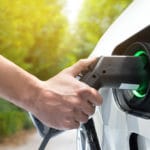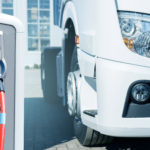Vehicle to Grid – An Overview
There are more than 80 V2G trials globally, with the majority of trials taking place in Europe where the world’s major automobile companies, distribution network service providers and electric car charger manufacturing companies are collaborating.
The V2G hub maps out V2G projects from around the world, which includes projects with physical deployment of V2G technology for a specific use case and excludes experimental research and narrow technology demonstration.
Companies can stay ahead of the game by taking part in V2G trials to test out the technology and evaluate the benefits for their fleet.
What is V2G?
Vehicle-to-grid (V2G) describes a system in which plug-in electric vehicles (EVs), such as battery electric vehicles (BEV) or plug-in hybrids (PHEV), communicate with the power grid to sell demand response services by either returning electricity to the grid or by throttling their charging rate.
V2G storage capabilities can enable EVs to store and discharge electricity generated from renewable energy sources such as solar and wind, with output that fluctuates depending on weather and time of day.
Benefits of V2G
V2G directs the charging and discharging of EV batteries based on users’ needs and the grid’s electricity supply, it allows the electricity grid to optimise the supply of local renewable energy and reduce infrastructure costs, while the EV owner can enjoy greener, more economical consumption of electricity and be financially rewarded for serving the electricity grid.
This means V2G comes with the following benefits for the EV owner and the distribution network:
- Supporting electrical grid, reducing concerns for grid overload
- Maximise the business case opportunity of your EVs
- Cheap and fast energy storage
- Making use of existing resources
- Reduction of environmental impact
How V2G works
V2G directs the charging and discharging of electric-vehicle batteries in accordance with users’ needs and the grid’s supply of available electricity. When electricity supply exceeds demand (notably during peak periods of renewable energy production), charging occurs at the maximum level; however, during peak electricity demand, vehicles can then supply electricity into the grid.
The figure below shows four models of V2G and the potential electricity and revenue flows across its stakeholders.
Challenges of V2G
The only technical disadvantage of V2G operation is the battery degradation due to the high number of charge/discharge cycles. Most electric car manufacturers are not providing warranty for V2G operations except a few i.e. Nissan and Mitsubishi. This strategy is still in its early stages to be implemented on a large scale.
Applications for V2G
Apart from providing local services at individual levels, when aggregated, EVs can also provide services to the grid for:
- Voltage regulation
- Frequency regulation
Optimal utilisation of the energy resources (electric cars as battery reserves) will result in minimum cost of energy consumption for the end users as well as reduced impact on the electric power grid.
Apart from V2G, it is worthwhile to think about V2X, which can be vehicle-to-grid, vehicle-to-building, vehicle-to-vehicle, vehicle-to-home. The concept remains the same with different applications.
Evenergi consulting for V2G
Evenergi can provide services for modeling the energy management systems by optimal utilisation of available energy resources.
Evenergi can also help facilitate V2G trials with industry partners such as distributed network supply providers (DNSPs), electric car manufacturers, electric car charger manufacturers, and state governments.
Contact Evenergi here.

 State Government – EV Grants and incentives
State Government – EV Grants and incentives EV Basics – EV Batteries
EV Basics – EV Batteries EV Fleet for Bus Operators
EV Fleet for Bus Operators EV Basics – Maximising EV efficiency
EV Basics – Maximising EV efficiency